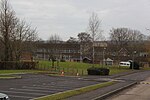Glastonbury Lake Village

Glastonbury Lake Village was an Iron Age village, situated on a crannog or man made island in the Somerset Levels, near Godney, some 3 miles (5 km) north west of Glastonbury in the southwestern English county of Somerset. It has been designated as a scheduled monument.It has been described as "the best preserved prehistoric village ever found in the United Kingdom". The site covered an area of 400 feet (122 m) north to south by 300 feet (91 m) east to west. It was first constructed 250 B.C. by laying down timber and clay. Wooden houses and barns were then built on the clay base and occupied by up to 200 people at any time until the village was abandoned around 50 B.C. The site was discovered by Arthur Bulleid in 1892 and excavated over the next 15 years. Artefacts uncovered include wooden and metal objects, many of which are now on display at The Tribunal in Glastonbury High Street, and in the Museum of Somerset in Taunton. Much of the timber was left at the site and soil put back on top of it as the best way to preserve it. Surveys in the late 20th and early 21st century have shown this to be effective, however the site is still at risk because of the risk of further drying out of the soil.
Excerpt from the Wikipedia article Glastonbury Lake Village (License: CC BY-SA 3.0, Authors, Images).Glastonbury Lake Village
Great Withy Drove,
Geographical coordinates (GPS) Address Nearby Places Show on map
Geographical coordinates (GPS)
| Latitude | Longitude |
|---|---|
| N 51.163611111111 ° | E -2.7258333333333 ° |
Address
Great Withy Drove
Great Withy Drove
BA6 9AD
England, United Kingdom
Open on Google Maps










